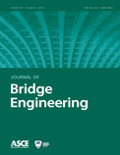
Journal of Bridge Engineering
Scope & Guideline
Exploring Cutting-edge Solutions for Bridge Challenges
Introduction
Aims and Scopes
- Sustainable Bridge Design:
Research on eco-friendly materials and design practices aimed at creating bridges that minimize environmental impact, as demonstrated by studies focusing on sustainable urban bridges. - Structural Analysis and Assessment:
Investigations into the structural integrity and performance of existing bridges, including methodologies for assessing their strength and safety under various loads and conditions. - Seismic and Dynamic Response:
Exploration of how bridges respond to seismic events and dynamic loads, including studies on vibration analysis and seismic retrofitting techniques. - Materials and Construction Techniques:
Examination of innovative materials and construction methods, including the use of composite materials and robotic welding processes, to improve the durability and efficiency of bridge components. - Numerical and Experimental Modeling:
Development of computational models and experimental studies to analyze the behavior of bridge systems, including dynamic response and deflection characteristics.
Trending and Emerging
- Sustainable and Green Engineering:
A growing emphasis on sustainable practices in bridge design, as seen in studies addressing eco-friendly materials and sustainable urban infrastructure, showcases a commitment to environmental stewardship. - Advanced Computational Methods:
The use of sophisticated numerical modeling techniques to analyze complex bridge behaviors and responses is increasingly prevalent, indicating a trend towards integrating technology in structural engineering. - Seismic Retrofitting and Resilience:
Research focused on enhancing the resilience of existing bridges against seismic threats has gained importance, particularly in light of recent natural disasters and the need for infrastructure safety. - Impact of Climate Change on Infrastructure:
Emerging studies examining the effects of climate change on bridge design and maintenance practices reflect a significant trend towards understanding and mitigating environmental impacts on infrastructure. - Innovative Construction Technologies:
The integration of robotics and new construction techniques in bridge engineering is on the rise, highlighting a shift towards efficiency and precision in construction processes.
Declining or Waning
- Traditional Bridge Materials:
Research focused on conventional materials such as steel and concrete in bridge construction has become less prominent, possibly due to the increasing interest in advanced composites and sustainable alternatives. - General Vibration Analysis:
While vibration analysis remains essential, the focus has shifted from basic analyses to more complex dynamic interactions and their implications for bridge safety under specific conditions. - Basic Structural Design Principles:
Studies that merely reiterate established structural design principles without novel applications or innovative methodologies are appearing less frequently, reflecting a trend towards more advanced and application-driven research.
Similar Journals
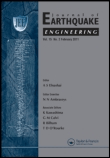
JOURNAL OF EARTHQUAKE ENGINEERING
Building a safer tomorrow with cutting-edge insights.JOURNAL OF EARTHQUAKE ENGINEERING, published by TAYLOR & FRANCIS LTD, stands as a pivotal resource in the fields of Building and Construction, Civil and Structural Engineering, and Geotechnical Engineering. With an impressive Q1 ranking in multiple categories for 2023, this journal is instrumental for researchers, professionals, and students committed to advancing knowledge in earthquake engineering and its practical applications. As a platform that spans the years from 1997 to 2024, it highlights significant contributions to safety, risk, reliability, and quality in engineering practices. While the journal operates on a subscription basis, its highly regarded articles, bolstered by robust Scopus rankings—such as rank #46 in Building and Construction—underscore its credibility and influence in shaping standards and methodologies within the discipline. Promoting innovative and evidence-based approaches, the JOURNAL OF EARTHQUAKE ENGINEERING is essential reading for anyone engaged in the science and technology of earthquake-resistant structures.

Journal of Materials and Engineering Structures
Innovating the Future of Materials ScienceJournal of Materials and Engineering Structures is a pioneering Open Access journal published by MOULOUD MAMMERI UNIVERSITY OF TIZI-OUZOU, dedicated to advancing the field of materials science and engineering. Since its inception in 2014, the journal has aimed to provide researchers, professionals, and students with a platform for sharing cutting-edge research and innovative applications in materials engineering and construction structures. Although the HIndex and Scopus ranking data are not specified, the journal plays a crucial role in disseminating knowledge that contributes to the development of sustainable and efficient engineering practices. With its commitment to accessibility and knowledge sharing in the heart of Algeria, the Journal of Materials and Engineering Structures is poised to make a significant impact on both local and global academic communities.
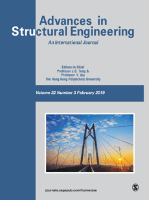
ADVANCES IN STRUCTURAL ENGINEERING
Transforming Ideas into Engineering ExcellenceADVANCES IN STRUCTURAL ENGINEERING, published by SAGE PUBLICATIONS INC, is a leading journal dedicated to the advancement of knowledge in the fields of Building and Construction, as well as Civil and Structural Engineering. With a solid impact factor and a commendable Scopus ranking (Rank #60 in Building and Construction, Rank #105 in Civil and Structural Engineering), this journal stands at the forefront of academic research, providing a platform for high-quality articles that contribute significantly to the discipline. Covering a range of topics from innovative construction techniques to sustainable engineering practices, the journal aims to foster collaborative dialogue among researchers, industry professionals, and students alike. As of 2023, it boasts impressive category quartiles, ranking Q1 in Building and Construction and Q2 in Civil and Structural Engineering. ADVANCES IN STRUCTURAL ENGINEERING is a vital resource for those looking to stay abreast of emerging trends and groundbreaking developments in structural engineering, promoting an environment of continuous learning and application of best practices. With a convergence of research from 1999 to 2024, the journal not only emphasizes theoretical frameworks but also bridges the gap between academia and practical application in engineering projects.

International Journal of Steel Structures
Unveiling the Potential of Steel in ConstructionWelcome to the International Journal of Steel Structures, a distinguished publication dedicated to advancing the field of civil and structural engineering since its inception in 2010. Published by the Korean Society of Steel Construction (KSSC), this journal aims to provide a platform for researchers and professionals to share innovative findings and essential insights related to steel structures, emphasizing both theoretical and applied research. With an impact factor that reflects its growing recognition—ranking in Q3 within the civil and structural engineering category—the journal has positioned itself as a significant contributor to the body of knowledge in this vital field. Although currently not an open-access publication, it remains an invaluable resource for students and scholars keen on exploring contemporary challenges and advancements in steel construction. Located in Seoul, South Korea, the journal continues to evolve, converging its presence into the future, with publication efforts spanning through to 2024. Engage with us as we explore the innovative applications and developments in the realm of steel structures.

Journal of Constructional Steel Research
Leading the Charge in Material Science DiscoveriesJournal of Constructional Steel Research, published by Elsevier Ltd, stands as a leading platform in the realm of constructional steel research since its inception in 1980. With a robust focus on Building and Construction, Civil and Structural Engineering, Mechanics of Materials, and Metals and Alloys, this prestigious journal has earned its place in the Q1 category across multiple disciplines, symbolizing excellence in scholarly contributions. The journal's impressive Scopus rankings further underscore its significance, ranking 30th out of 223 in Building and Construction, and exhibiting strong standings in other related fields. Researchers, professionals, and students will find this publication an invaluable resource, offering access to the latest findings and innovations in constructional steel, necessary for advancing practices in engineering and material sciences. Although it does not operate under an open-access model, the content is meticulously curated to ensure high-quality, peer-reviewed research, continuing to shape the future of steel construction methodologies.
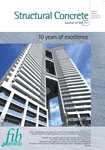
Structural Concrete
Pioneering Research in Concrete TechnologiesStructural Concrete, published by ERNST & SOHN, is a premier journal dedicated to the field of Civil and Structural Engineering, focusing on innovative research and advancements in concrete materials and technologies. With an impressive impact factor and a consistent ranking in the Q1 category of both Building and Construction and Civil and Structural Engineering, the journal stands as a vital resource for researchers, professionals, and students alike. It is indexed with notable Scopus ranks, underscoring its significance within the academic community. The journal spans a comprehensive scope (from 2001 to the present) that encompasses diverse topics related to the behavior, design, and application of structural concrete. Although not an open access publication, it offers valuable insights and cutting-edge knowledge that contribute to the ongoing evolution of construction practices and materials science. Structural Concrete is an essential platform for sharing pioneering findings and fostering collaboration within this dynamic field.

Frontiers of Structural and Civil Engineering
Innovating Solutions for Tomorrow's Structural ChallengesFrontiers of Structural and Civil Engineering, published by HIGHER EDUCATION PRESS, is a premier academic journal dedicated to advancing the fields of architecture, civil, and structural engineering. With an ISSN of 2095-2430 and E-ISSN of 2095-2449, this journal caters to the dissemination of high-quality research and innovative practices from 2012 onwards, highlighting important developments up until 2024. Ranked in the top quartile (Q1) for Architecture and Q2 for Civil and Structural Engineering in 2023, it holds an impressive Scopus ranking of #19 out of 189 in Architecture and #101 out of 379 in Civil and Structural Engineering, reflecting its impact and relevance in the scientific community. This journal invites contributions that demonstrate pioneering approaches, fostering collaboration among researchers, professionals, and students alike, and significantly contributes to the global knowledge base in the engineering disciplines.

Magazine of Civil Engineering
Connecting Research and Practice in Civil EngineeringMagazine of Civil Engineering, published by ST-PETERSBURG STATE POLYTECHNICAL UNIVERSITY, is a prominent open access journal dedicated to the field of civil and structural engineering. With an ISSN of 2712-8172 and E-ISSN 2071-0305, it serves as a vital platform for disseminating high-quality research, innovative methodologies, and current trends in building and construction. Since its inception in 2010, the journal has embraced open access, ensuring broad visibility and accessibility for its contributions to the academic community. The magazine holds a respectable position in the academic hierarchy, ranked in the Q3 quartile for both Building and Construction and Civil and Structural Engineering categories as of 2023. It is indexed in Scopus, amplifying its societal impact and reach with a rank of #114/223 in Building and Construction and #224/379 in Civil and Structural Engineering. Researchers, professionals, and students alike are encouraged to engage with the cutting-edge studies presented in the magazine, contributing to the advancement of knowledge and practice within the civil engineering domain.
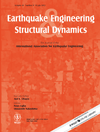
EARTHQUAKE ENGINEERING & STRUCTURAL DYNAMICS
Advancing seismic safety through innovative research.EARTHQUAKE ENGINEERING & STRUCTURAL DYNAMICS, published by Wiley, is a leading journal recognized for its significant contributions to the domains of civil and structural engineering, as well as geotechnical engineering and engineering geology. With an impressive Q1 ranking in multiple categories, including Civil and Structural Engineering, and an esteemed Scopus ranking placing it in the 82nd percentile, the journal serves as a premier platform for disseminating pioneering research and innovative methodologies related to earthquake engineering and dynamic structural analysis. Established in 1972, this journal boasts a comprehensive coverage of topics from theoretical developments to practical applications, making it an essential resource for researchers, industry professionals, and students eager to expand their understanding of seismic safety and structural resilience. Though it does not offer open access, the journal continues to be a cornerstone for scholarly communication within the earthquake engineering community, advancing knowledge that shapes better engineering practices worldwide.

STEEL AND COMPOSITE STRUCTURES
Pioneering Insights in Composite Materials and Steel StructuresSTEEL AND COMPOSITE STRUCTURES is a leading academic journal published by TECHNO-PRESS, dedicated to the fields of Building and Construction, Civil and Structural Engineering, and Materials Science. With a notable Impact Factor and classified in Q1 and Q2 quartiles in multiple relevant categories as of 2023, the journal provides a high-quality platform for the dissemination of innovative research from its converged publishing years of 2004 to 2024. The journal's rigorous peer-review process ensures that only the most impactful studies receive publication, fostering advancements in composite materials and steel structures. Researchers, professionals, and students alike can gain valuable insights into current technologies and applications in these critical fields, making STEEL AND COMPOSITE STRUCTURES an essential resource for anyone involved in structural engineering and materials research. The journal is based in South Korea, and while it offers traditional access options, the breadth of its contributions ensures a global reach and influence.